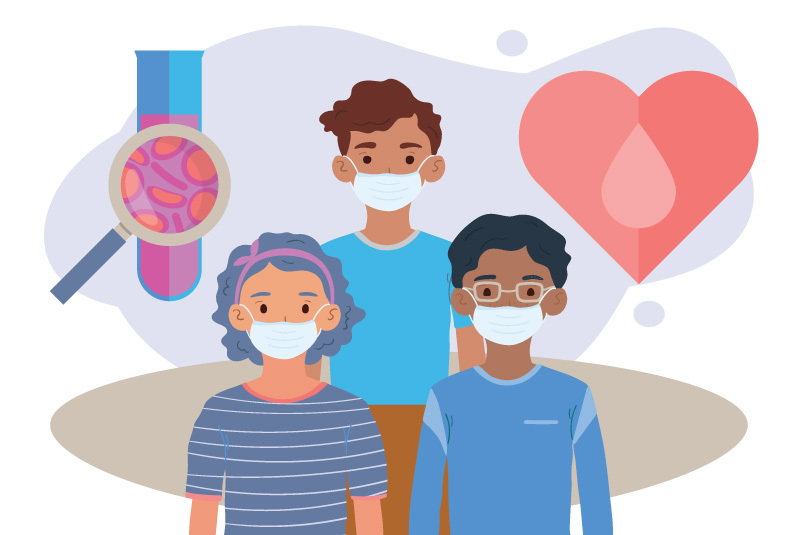New findings show risk of bleeding and clotting after COVID-19

A year after COVID-19 was first identified, we have some answers about how to prevent and treat this illness, but there are still many questions. Some of the unknowns include what longer-term effects COVID-19 infection may have on the heart and other systems in the body.
One of the complications associated with COVID-19 infection is the risk of developing blood clots, called thrombosis. While thrombosis has been reported in adult patients, the risk for children hasn’t been so clear. But recently, heart surgeon Dr. Sitaram Emani and his colleagues at Boston Children’s Hospital have begun to see a worrying trend in bleeding and clotting in children, especially in those with congenital heart disease (CHD).
Key takeaways:
- We have seen some CHD patients with COVID-19 develop a tendency for blood clots, possibly related to hypercoagulability (high clotting risk), even if they had minor COVID-19 symptoms.
- Our lab testing (TEG) data shows a tendency towards clotting in pediatric CHD patients with COVID-19 compared to non-COVID-19 CHD patients.
- Families should continue to maintain preventive measures (social distancing and masking) to prevent exposure to COVID-19.
- CHD patients who develop COVID-19 should let their doctor know. Discuss the need for further investigation into risk of clotting.
- For patients with CHD and COVID-19, continue taking all medications and talk with your doctor before making any changes.
“Any time we have a patient in the hospital who has COVID-19, we send a battery of tests, including tests for coagulation, which measure clotting risk,” says Dr. Emani, who serves as medial director for the Heart Center’s coagulation laboratory.
The coagulation laboratory at the Heart Center runs a type of coagulation testing not available at most hospitals, called thromboelastography (TEG), an especially sensitive test that provides detailed information about coagulation. Dr. Emani says they recently started to notice some patients with COVID-19 had hypercoagulability, or a high risk of clotting.
A concerning change in clotting
“At first, we thought it was some sort of miscalculation, but once we started analyzing the data more systematically, we realized that there was a very significant difference between the coagulation status of heart patients who had COVID-19 and the coagulation status of other heart patients,” says Dr. Emani.
Even more worrisome, they have started to see some children with CHD coming in with bleeding and clotting complications. “When we started to see kids with thrombosis events, including stroke, we realized we really have to focus on this issue,” says Dr. Emani. “Families and doctors need to be aware this is happening.”
This is a noticeable change from what Dr. Emani and his colleagues had seen last year, when they presented their findings at the American Heart Association meeting in in November 2020. While that study showed some children were at risk of clotting, at that time they were not seeing any children presenting with actual clotting complications.
However, he notes that the severity of COVID-19 symptoms doesn’t appear to play a role in bleeding or clotting risk. Even children who have no symptoms or very mild symptoms of COVID-19 can still be at risk for events.
Actions for physicians and parents of children with CHD
Dr. Emani says that physicians and parents of children with congenital heart disease who test positive for COVID-19 should be aware of this risk and take the following actions:
- Parents: Make sure to see your child’s cardiologist — even if your child had no symptoms — and ask if additional testing would be of value.
- Physicians: Talk with parents and patients about COVID-19 exposure and possible risks. Even asymptomatic patients may warrant further testing based on their underlying conditions and risk factors.
Advice for all parents
Dr. Emani says that while he’s currently seeing hypercoagulability on lab testing in patients with CHD, it may also be a risk for kids with other types of bleeding or clotting issues. He recommends checking with your doctor if you have any questions.
While they are continuing to learn more by monitoring patients and collecting data, Dr. Emani urges everyone, especially families with a child who has CHD, to continue prevention measures against COVID-19.
“While a lot of places are relaxing guidelines, it’s important to stay vigilant,” says Dr. Emani. “People with CHD and other chronic conditions should beware of COVID-19 because there are real potential complications.”
Learn more about the Department of Cardiac Surgery and Boston Children’s response to COVID-19.
Related Posts :
-

Promising advances in fetal therapy for vein of Galen malformation
In 2024, Megan Ingram* of California and her husband were preparing for the birth of their third child when a 34-week ...
-

Four things you should know about MAPCAs treatment
As the first grandchild in her family, Hannah Homan is in demand for frequent visits. She was also the focus ...
-

The hidden burden of solitude: How social withdrawal influences the adolescent brain
Adolescence is a period of social reorientation: a shift from a world centered on parents and family to one shaped ...
-

Treating MAPCAs with unifocalization surgery and cardiology care
Children born with a rare form of tetralogy of Fallot (ToF) face a challenging type of congenital heart ...





